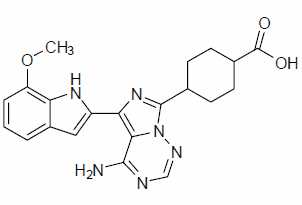All AbMole products are for research use only, cannot be used for human consumption.

OSI-027 is a potent, orally bioavailable mammalian target of rapamycin (mTOR) kinase inhibitor with potential antineoplastic activity. OSI-027 shows more than 100-fold selectivity for mTOR relative to PI3Kα, PI3Kβ, PI3Kγ and DNA-PK. OSI-027 inhibits phosphorylation of the mTORC1 substrates 4E-BP1 and S6K1 as well as the mTORC2 substrate AKT in diverse cancer models in vitro and in vivo. OSI-027 potently inhibits proliferation of several rapamycin-sensitive and -insensitive nonengineered and engineered cancer cell lines and also, induce cell death in tumor cell lines with activated PI3K-AKT signaling. In contrast to rapamycin, OSI-027 induced apoptosis in a variety of lymphoid cell lines and clinical samples, including specimens of B-cell acute lymphocytic leukemia (ALL), mantle cell lymphoma, marginal zone lymphoma and Sezary syndrome. Furthermore, OSI-027 shows superior efficacy compared with rapamycin in COLO 205 and GEO colon cancer xenograft models. OSI-027 is currently in phase I clinical trials in cancer patients.
| Cell Experiment | |
|---|---|
| Cell lines | MDA-MB-231, MDA MB 435, PC-3, OVCAR-3, A549, DU145, NCI-H2122, U 87 MG and ACHN cell lines |
| Preparation method | For assays of cell proliferation, cells were seeded into 96-well plates and incubated for 3 days in the presence of OSI-027 or OXA-01 at various concentrations. Inhibition of cell growth was determined by luminescent quantification of intracellular ATP content using CellTiterGlo® (Promega). Proliferation on Day 0 vs. 72h was used to plot dose-response curves for IC50 calculations and to determine cell death. |
| Concentrations | 0.1~1μM |
| Incubation time | 72 h |
| Animal Experiment | |
|---|---|
| Animal models | nu/nu CD-1 mice bearing MDA-MB-231 xenograft model |
| Formulation | 20% Trappsol |
| Dosages | 25 or 65 mg/kg QD for 14 days |
| Administration | orally |
| Molecular Weight | 406.44 |
| Formula | C21H22N6O3 |
| CAS Number | 936890-98-1 |
| Solubility (25°C) | DMSO 17 mg/mL |
| Storage |
Powder -20°C 3 years ; 4°C 2 years In solvent -80°C 6 months ; -20°C 1 month |
| Related mTOR Products |
|---|
| RMC-4627
RMC-4627 is a selective mTORC1 inhibitor that activates 4EBP1 and inhibits tumor growth. |
| RMC-4529
RMC-4529 has an IC50 value of 1.0 nM against p-4E-BP1-(T37/46) in mTOR kinase cellular assay. |
| WYE-687 dihydrochloride
WYE-687 dihydrochloride is an ATP-competitive mTOR inhibitor with an IC50 of 7 nM. |
| Rapamycin-d3
Rapamycin-d3 |
| L-Leucine-d10
L-Leucine-d10 |
All AbMole products are for research use only, cannot be used for human consumption or veterinary use. We do not provide products or services to individuals. Please comply with the intended use and do not use AbMole products for any other purpose.


Products are for research use only. Not for human use. We do not sell to patients.
© Copyright 2010-2024 AbMole BioScience. All Rights Reserved.
